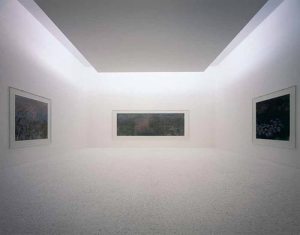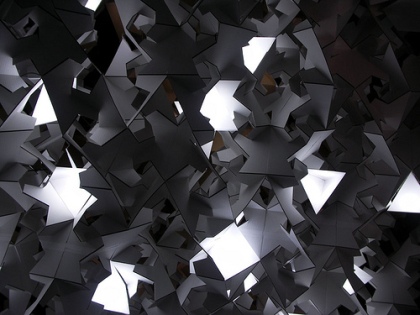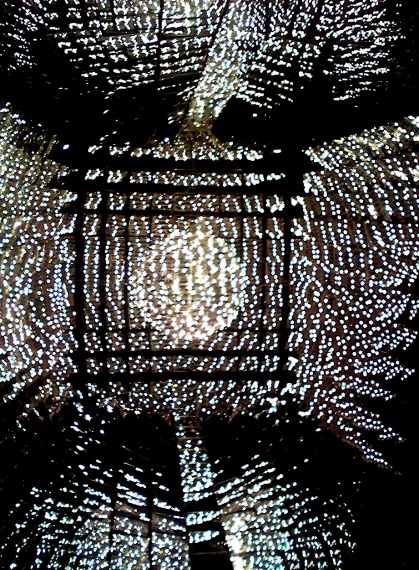Filed under: Japan | Tags: Ando, architecture, art, Benesse House, Chichu art museum, Naoshima, Sanaa
This year’s Golden Week made headlines for having the best Golden Week-weather in recent memory. Kansai, the week went without a single rainy day. During the weekend I had the chance to take full advantage of the great weather during a day trip to Naoshima.
Naoshima is a tiny island in the Seto Island Sea, which the seas between the main island, Honshu, and Shikoku. Getting there requires a twenty minute ferry ride from Okayama City and, in my case, a two-hour car ride from my old haunting grounds in Ako. Until recently, Naoshima was a fairly unknown, sparsely inhabited island. However thanks to the Benesse House complex and works in recent years by Pritzker prize winning architects Tadao Ando and the Tokyo-based SANAA, the town has become and art enthusiasts pilgrimage site.
As you might have noticed from this blog, I am pretty big fan of Tadao Ando. While my appreciation originates with his work that he did on the Contemporary Museum in my hometown, St. Louis, I have become a genuine admirer of buildings. I think this can partly be attributed to that fact that I have had to chance to see a number of his sketches and plans, and have a feel for the amount of thought that went into to his process. I also think that as a self-loathing pack rat, I really admire the simpleness and beauty of clean open areas and nice geometric shapes–these things are scare in my life.
The Benesse House, designed by Ando, must have been a challenging concept. The building is both a modern art museum and a luxury hotel. Luxury hotels aren’t the type of building that are in Ando’s wheelhouse. Who wants to pay $400 a night to sleep in a room with bare concrete walls–the answer of course is people who pay millions of dollars for Pollack’s splatterings and Morris’s stripes and Klein’s Color, so imagine many people find it money well spent. I didn’t check out the room situation personally, but the rest of the hotel was filled with gallery rooms with a moderately sized collection of art. I really felt as though the layout of the hotel framed the Seto Sea and the surroundings very nicely. The balconies has great perspectives of the coast, and the interior of the building flowed really nicely. If anything, some of the building concepts were too nice and made you forget about the art. (this might be the biggest whine wine on the Internet right now)
The pinnacle of the island was the ChiChu Art Museum, also designed by Ando. The museum sits a couple hundred meters up the hill from the hotel. The building is entirely under ground, with the exception of a few lighting windows, the emerge from the top of the mountain to let light into the galleries. In fact, from above the only clear indication that the museum exist are the windows that protrude from the ground to let light into the museum below.
There are only three displays inside the museum (well four if you count the museum itself). Two of them are interesting installations, and the third is the Monet collection. By far, I enjoyed the Monet room the most. I must confess that before entering this room, I don’t think I had ever had an enjoyable Monet experience. That’s not to say I hated his work, but if I was going to make a list of artist I liked, I would probably not put him on the list, or probably only would so as to not to appear foolish or uncultured. The Monet room at the ChiChu art museum changed that. Mostly because looking at Monet in the ChiChu Art Museum is like looking at Monet in Space, in the future, hundred of years from now. To enter the room you have to take off your shoes, and put on sandals. The floor is made of small soft white stones, that somehow have the sensation of walking on felt. On the walls five paintings hang, only illuminated by the small amount sunlight let in from above. The painting are encased in plexi-glass, free of the tradition frame. It would be cliche to say that I saw them in a new light, but something about the way these paintings were prepared allowed me to appreciate them in way I did not before. That said, it will probably also make me critical of any other Monet I see, just hanging there, displayed in a manner that I know is highly inferior.
The only draw back of the island (if you call it a drawback) seems to be a popular destination especially amongst foreigners. While the island was packed over Golden week, we had to wait and hour and half to gain entrance to the museum, the crowd there had to be the highest ratio of foreigners of anywhere I have seen in Japan, Kyoto included. Also, while we arrived on time for our ferry, the ferry was already full and we were forced to wait an hour and half for the next one, which of course was when we learned that the island doesn’t have many restaurant options, but that’s minimalism for you.
Filed under: Uncategorized | Tags: 2009, art, art in containers, Biennale, Kobe, meriken park

I’m usually not a huge fan of installation art–I find it too often grays the area between art and furniture. Not that the two mediums are mutually exclusive. Instead, I would say that it’s extremely difficult to be just a good artist or just a good interior designer. The ambitious blending of these two fields tends to result in things like pieces of garbage hanging from the ceiling with fishing line or chairs made of broken glass.
That in mind, this weekend I went to Kobe Biennale art exhibition. The exhibition takes place at many sites through the city, however the focal point was in Meriken Park, at the Port of Kobe. There, organizers had a erected a small, improvised outdoor museum.
The highlight of the Biennale was the “Art in Containers” International Exhibition. Thirty contemporary artists–all who have some connection to Kobe–were chosen, and each were tasked with creating an installation piece inside a 40 ft. deep shipping container.
As I said before, I am not a huge fan of installation art; however, I do think the utilization of shipping containers buoyed the effectiveness of some of these pieces. Having a defined space provided a clear segmentation between each piece while elegantly condensing and focusing some of the art in a manner that enhanced the experience.
That’s not to say that I loved every piece. Some of them were the typical over-thought and under executed installations that modern art is often criticized for. There was the boring 3-D animation from the early 90’s on a wall container, and another that was simply a dark space with weird sounds. I actually didn’t stay in the any of the darkened containers for any extended period of time. I’ve seen to many crime shows to feel safe when alone in a pitch-black shipping container; at any moment the door could slam shut and not reopen until days later some detective finds your frozen, dead body in Arkhangelsk and he then has to get in his Lieutenants face just to start making inquiries with the local organized crime syndicates.
On the whole, many of the installations were interesting. My particular favorite involved a container where the walls and ceiling were covered in tiny wall clocks. The sound of hundreds of clocks ticking simultaneous was one of those unique art experiences (clock shops excluded). Also, a in the container at the same time as me lady had the audacity to touch one of the clocks. Of course, the clock she touched and another fell off the wall and shattered on the floor. I somehow was able to catch the entire spectacle from her initial arm extension to her sever and instantaneous reaction of regret (it’s a universal expression). I don’t really like performance art either but this was like my own private candid camera show, except for the part where she actually looked at me and I had to quickly reply “daijobu” (everything is okay).
Also, this is Japan, so there was some cool large scale origami. There were other containers that had a more circus atmosphere–funny mirrors and one with just a bunch of fans and mounds of confetti that you could play in. While one might dispute the artistic endeavor of these installations, the fun quotient of them can really be debated.
Filed under: Uncategorized | Tags: Ando, Archimbaldo, art, hyogo, Japan, Prefectural Art Museum, Tadao, Visual Deception

This weekend I went to the Hyogo Prefectural Museum of Art. The museum is a little far from me– about an hour and half away (one stop past Sannomiya); however, their current exhibition, Visual Deception, seemed like proper impetus to make the trip.
Tadao Ando designed the museum, so the building itself was part of the draw as well. I have been impressed with his buildings whenever I encounter them. The Contemporary Art Museum in St.Louis was probably my first cognizant exposure to Ando’s work. I also like the that a former boxer from Osaka who never received any formal architectural training has this great sense of shape and framing the amazing views his buildings create. It’s like someone gave Avon Barksdale a T-square.
Ando is perhaps most famous for his concrete construction method where many of the interior and exterior walls are simple, smooth (yet not flawless) exposed concrete slabs. He is not the first architect to use this method (so I’m told) but the way he uses it and his consistency with the material have made it a signature of his work.

play stairway to museum
The Hyogo Prefectural Museum was unlike the Contemporary Museum in many ways; namely it was bigger and used a much darker color pallet for the ceiling and walkway ornamentation (if one could call it that). A first I wasn’t sure how I felt about the building. From the exterior there are hints that it might be part of some terrible future dystopia imagined in the 80’s. Inside, however, the building is really quite elegant. There are a number of long, geometrically-magnificent spaces. The stairways range from the massive and wide forum variety to winding Escher-like narrow stairs that spiral down wall of rectangular corridor. The darker pallet also helps to balance out large amount of light pulled from the outside. Without a dark colored ceiling the contrast between the spaces and the sight lines created would be lost.
While I enjoyed the building, the way the exhibition was highly imperfect. Apparently in Japan, and exhibition cannot sell out. This means people funnel in to the exhibit as quickly as they can. Unfortunately for me, this was a fairly popular exhibit.

more stairways
My girlfriend and I were smart enough to buy tickets to the exhibition at the train station–who knew you could do that–and this allowed us to bypass the ticket-buying line which reports suggested was about an hour long. However, we still had to wait ten minutes in the Exhibition entrance-line. This was not terrible, however the opening room to the exhibition was extremely crowded. The room itself was large, however everyone was crammed along intermittent pieces of wall space that held the works of art. The Exhibits signature pieces by Giuseppe Achimboldo (below) were particularly crowded.

This guy's a vegetable
The entire scene was pretty much a foreigner’s nightmare museum experience.It hit a number of the bad museum experience pressure points;
- It’s lots of people who are used to being crammed into trains at rush hour, so they abandon all respect for personal space and cram around you as much as possible.
- It’s a crowd that skews slightly on the elderly side, so they are moving as slowly as possible.
- I am the tallest person, so if I’m in front, I am the one ruining it for everybody–as such I am forced to observe from the back of the pack
- There’s around round of “the new” flu going around (perhaps this is swine flu II, I don’t know) so everyone is either wearing masks that don’t work or sneezing on people wearing mask.
It was a tad bit hellish.
After a few minutes I made the executive decision to forgo context and simply move to ahead of the crowd when possible and try to intimately view a few pieces of art rather than try to see everything trudging along with the mases.
It was a good decision. There were several rooms dealing with the Dutch and French master who developed and played with the depiction of depth and perspective. This was followed room tying in Japanese scroll and Ukiyoe printing into the development of visual illusions and depth before finally taking off with the modern pieces.
The exhibit had one a the more interesting collections of Magritte’s work that I had seen and I really did enjoy, what I perceive to be, his sense of humor about perception and reality. The highlight of the exhibition for me was a piece by Patrick Hughes, which depicts a Venetian style sea city. The piece is painted on a 3D canvas, where the triangular blocks of wood just out from the wall towards you. The scene is painted in such a way that as you move the depth and lighting changes altering what you see and creating the illusion of an actual cityscape.
Overall the exhibit was pretty great. The modern pieces at the end were a nice pay-off. The crowds however did little to change my perspective that museum visits in Japan should be remain rare occurrences.












